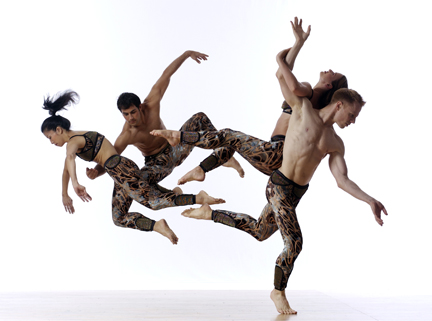Taylor Company Ends Season
“Dante Variations," "Sunset," "Esplanade"
Paul Taylor Dance Company
City Center
New York, NY
March 18, 2007
copyright ©2007, Leigh Witchel
 Paul Taylor’s company closed its New York season with a substantial triple bill. “Dante Variations,” the most recent work (2004), led off and was the darkest in mood. Its equivocal metaphysics recalls “Fiends Angelical,” made three years previous to it. Annmaria Mazzini enters to dance a solo with her wrists bound by a white cloth; a similar cloth is stuck persistently to Robert Kleinendorst’s foot. Michael Trusnovec is at the apex of a pyramid of souls to open; he and Lisa Viola dance an extended pas de deux that turns into a game of blind man’s buff.
Paul Taylor’s company closed its New York season with a substantial triple bill. “Dante Variations,” the most recent work (2004), led off and was the darkest in mood. Its equivocal metaphysics recalls “Fiends Angelical,” made three years previous to it. Annmaria Mazzini enters to dance a solo with her wrists bound by a white cloth; a similar cloth is stuck persistently to Robert Kleinendorst’s foot. Michael Trusnovec is at the apex of a pyramid of souls to open; he and Lisa Viola dance an extended pas de deux that turns into a game of blind man’s buff.
György Ligeti seems to be this decade’s Arvo Pärt. Taylor has used the “Musica Ricercata” that is also familiar from Christopher Wheeldon’s “Polyphonia,” but Taylor added a twist by using a scoring for barrel organ. It gives the music a grating, circus-like quality appropriate to the punishments he metes out. Taylor puts an epigram in the program from Canto III of the “Inferno”: “These are the nearly soulless whose lives concluded neither blame nor praise.” He sets before us the souls Dante described trapped at the gates of Hell — apathetic in life; they chose neither good nor evil and have been refused by both Heaven and Hell. Taylor, in his mood of weird medieval humor, has them condemned to an eternity of petty annoyances.
“Sunset,” from 1983, is one of Taylor’s beautiful elegies to British music. Its agrarian partner is 1997’s “Eventide.”; the earlier work is to Elgar and the later to Vaughan Williams. “Sunset” is set near water; Alex Katz’s set evokes the railing of a pier, and we hear the cries of loons. Five soldiers on leave and four women interact in a subtle play of emotions that has changed with every cast. A duet originally danced by Christopher Gillis and David Parsons was done here by Kleinendorst and Trusnovec. It’s about camaraderie, but there could be an underlying sexual tension. It flickered in and out, but if I were forced to describe the relationship the two men outlined at this performance, it was that Kleinendorst’s character was attracted to Trusnovec and that Trusnovec did not have a clue of it (and maybe Kleinendorst didn’t either). Richard Chen See took a very literal approach to the role Elie Chaib created. At one point, that man is carried by four women; when Chaib did it he was a potentate, luxuriating in the women’s attention. Chen See lay in their arms like a casualty of war, turning that playful moment — with deeper echoes — grim. Perhaps it’s the times that prompted that. Mazzini took Lila York’s sweet role of the girl who climbs up the men’s backs as if they were steps. Mazzini has carved out a place in the company playing the tough girl who gets the short end of the stick. It’s a nice change to see her in roles such as this or her part in “Esplanade.”
As with “Big Bertha” two seasons ago, “Esplanade” got a sex change. Orion Duckstein took Bettie de Jong’s central role in the slow movement. Taylor prefers making new works to remounting old ones; the casting shuffle is a way for him to keep his vision of the piece fresh. When Patrick Corbin did de Jong’s part in “Big Bertha,” he did it in drag; Duckstein doesn’t have to go that far; the role is the same, but done by a man. One would have assumed the change would affect the dance, and it did, but in completely unexpected ways. Duckstein did not seem pivotal the way any woman in the part has, but rather, he was subsumed into the corps. Some of that was prompted by the visual cues of the costuming. De Jong wore pants (the other women are skirted) in a different color from everyone else. Duckstein wears much the same outfit and colors as the other men and so seems to blend in. This reading didn’t resonate; there’s no sense of need or loss.
The cast looked comfortable in the piece; there was a time a few years back when the dancers looked stumped by it. Mazzini repeatedly throws herself to the floor in the final movement with fearless or foolhardy courage, depending on how your knees react in sympathy. In the finale, Viola does her specialty – the long jump into her partner’s arms. “Esplanade” is a beautiful work. Moving us back in time to the beginning of an epoch for the company — the first dance Taylor made after ceasing to perform himself — it sent folks home happy at the season’s close.
Photo by Lois Greenfield. Lisa Viola, Robert Kleinendorst, Annmarie Mazzini, and Michael Trusnovec.
Volume 5, No. 12
March 26, 2007
copyright ©2007 by Leigh Witchel
www.danceviewtimes.com